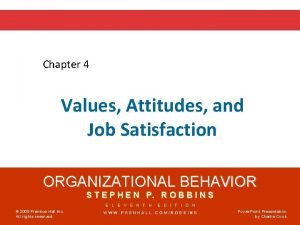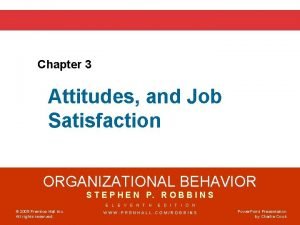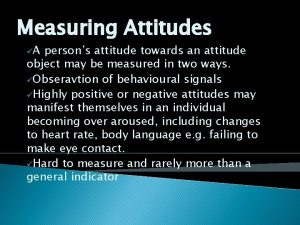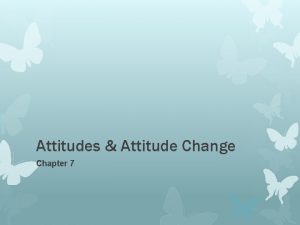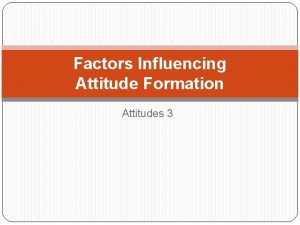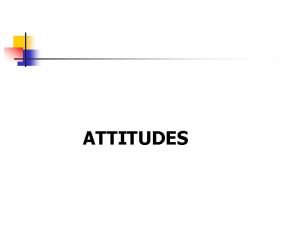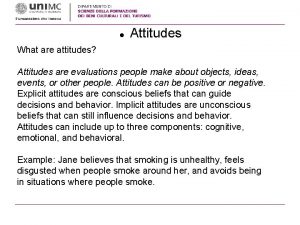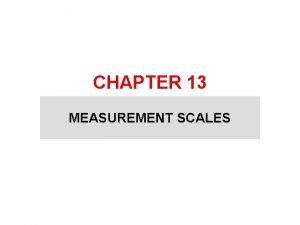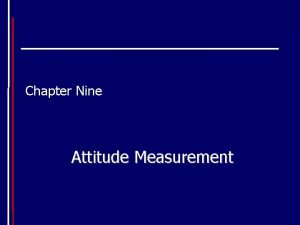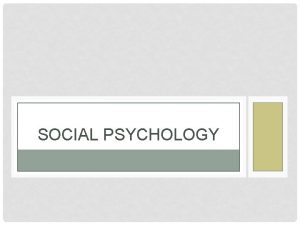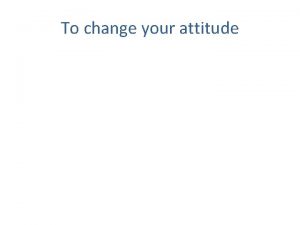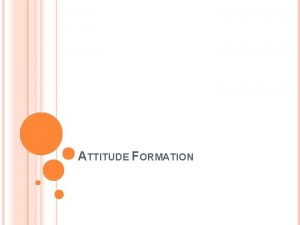Attitudes Chapter 7 The Power of Attitudes Attitude


























- Slides: 26

Attitudes Chapter 7

The Power of Attitudes • Attitude: – A lasting, general evaluation of people (including oneself), objects, advertisements, or issues – Anything toward which one has an attitude is called an object (Ao). – Attitudes are lasting because they tend to endure over time. t ec f f Cognition A Attitude 2

The Functions of Attitudes • Functional Theory of Attitudes: – Attitudes exist because they serve some function for the person (i. e. , they are determined by a person’s motives) • Katz’s Attitude Functions – Utilitarian function: obtain rewards / avoid punishments – Value-expressive function: express identify to others – Ego-defensive function: self-protection – Knowledge function: simplifies decisions, e. g. , Brand loyalty 3

Addressing Smoking Attitudes • This Norwegian ad addresses young people’s smoking attitudes by arousing strong negative feelings. The ad reads (left panel) “Smokers are more sociable than others. ” (Right panel): “While it 4 lasts. ”

The ABC Model of Attitudes • Affect: – The way a consumer feels about an attitude object • Behavior: – Involves the person’s intentions to do something with regard to an attitude object • Cognition: – The beliefs a consumer has about an attitude object • Hierarchy of Effects: – A fixed sequence of steps that occur en route to an attitude 5

Hierarchy of Effects Figure 7. 1 6

Hierarchy of Effects • Standard Learning Hierarchy – Results in strong brand loyalty – Assumes high consumer involvement • Low-Involvement Hierarchy – Consumer does not have strong brand preference – Consumers swayed by simple stimulus-response connections • Experiential Hierarchy – Consumers’ hedonic motivations and moods – Emotional contagion – Cognitive-affective model vs. independence hypothesis 7

Product Attitudes Don’t Tell the Whole Story • Attitude Toward the Advertisement (Aad): – A predisposition to respond in a favorable or unfavorable manner to a particular advertising stimulus during a particular exposure occasion • Ads Have Feelings Too: – Three emotional dimensions: • Pleasure, arousal, and intimidation – Specific types of feelings that can be generated by an ad • Upbeat feelings: Amused, delighted, playful • Warm feelings: Affectionate, contemplative, hopeful • Negative feelings: Critical, defiant, offended 8

Ads Have Feelings Too • Commercials evoke emotion – Pleasure – Arousal – Intimidation 9

Attitude Toward the Ad • We form attitudes toward objects other than the product that can influence our product selections • We often form product attitudes from its ads – Aad: attitude toward advertiser + evaluations of ad execution + ad evoked mood + ad arousal effects on consumer + viewing context 10

Forming Attitudes (cont. ) • Cognitive Dissonance and Harmony among Attitudes: – Theory of Cognitive Dissonance: When a person is confronted with inconsistencies among attitudes or behaviors, he or she will take action to reduce the dissonance by changing an attitude or modifying a behavior. • Self-Perception Theory: – People maintain consistency by inferring that they must maintain a positive attitude toward a product they have bought or consumed • Foot-in-the-door technique: – Sales strategy based on the observation that consumers will comply with a request if they have first agreed to comply with a smaller request 11

Levels of Attitudinal Commitment • By describing Cadillac as “my company, ” the woman in this ad exhibits a high level of attitudinal commitment to 12 her employer.

Social Judgment Theory • We assimilate new information about attitude objects in light of what we already know/feel – Initial attitude = frame of reference – Latitudes of acceptance and rejection • Assimilation and contrast effects • “Choosy mothers choose Jif peanut butter” 13

Balance Theory • Triad: – An attitude structure consisting of three elements • (1) A person and his/her perceptions of • (2) an attitude object, and • (3) some other person or object • Unit relation: – An element is seen as belonging to or being part of the other • Sentiment relation: – Two elements are linked because one has expressed a preference for the other • Marketing Applications of Balance Theory – Celebrity endorsements 14

Alex Figure 7. 2: Balance Theory Larry Earring + Alex Larry + Alex + Larry + Earring + Larry O Earring Alex Larry Earring 15

Balance Theory (Cont’d) • Marketing Applications – “Basking in reflected glory” – Unit relation with popular product = positive sentiment relation in other people’s triads – Celebrity endorsers of products 16

Multi-attribute Attitude Model (Fishbein) BELIEF: – Salient beliefs (important attributes) – Strength of the belief (product’s score on attribute) EVALUATION: (attribute’s importance to you) ATTITUDE = SUM OF (SCORE ON ATTRIBUTE X IMPORTANCE OF 17 ATTRIBUTE)

Multi-attribute Attitude Models • Three elements – Attributes of AO (e. g. , college) • e. g. , Scholarly reputation – Beliefs about AO • e. g. , University of North Carolina is strong academically – Importance weights • e. g. , Stressing research opportunities over athletics 18

The Theory of Reasoned Action By Fishbein et al to improve on Multiattriube model. – Includes subjective norms: how other people feel about the behavior. – Assesses the consumer’s attitude toward the overt behavior of purchasing the product rather than toward the object itself. – Uses consequences of the behavior rather than attributes of object. 19

Extended Fishbein Model • Research: low correlation between reported attitude and actual behavior – We love commercials, yet still not buy! • Theory of reasoned action – Intentions vs. behavior • Conviction and past purchase behavior • Behavioral intentions – Social pressure • SN = NB + MC – Attitude toward act of buying 22

Associative Network for Snickers Chocolate Bar Yummy Fattening Nuts Chocolate Give Cavities Dentist 23

Activation at Dentist’s Office Yummy Fattening Snickers Bar Chocolate Give Cavities Nuts Dentist 24

Attitude Formation Yummy Snickers Attitude Fattening Snickers Bar Chocolate Give Cavities Nuts Dentist 25

Trying to Consume • Theory of trying – Criterion should be trying to reach goal – Intervening factors between intent and performance – Several new components to account for act of trying 26

Theory of Trying Figure 7. 3 27

Tracking Attitudes over Time • Attitude-tracking program: – An single-attitude survey is a snapshot in time – A program allows researchers to analyze attitude trends during an extended period of time • Ongoing Tracking Studies – Attitude tracking involves administration of a survey at regular intervals (e. g. Gallup Poll, Yankelovich Monitor) – This activity is valuable for making strategic decisions 28
 Real power formula
Real power formula Instrument cross check
Instrument cross check The globe framework for assessing cultures
The globe framework for assessing cultures Chapter 3 attitudes and job satisfaction
Chapter 3 attitudes and job satisfaction Hình ảnh bộ gõ cơ thể búng tay
Hình ảnh bộ gõ cơ thể búng tay Bổ thể
Bổ thể Tỉ lệ cơ thể trẻ em
Tỉ lệ cơ thể trẻ em Voi kéo gỗ như thế nào
Voi kéo gỗ như thế nào Glasgow thang điểm
Glasgow thang điểm Chúa sống lại
Chúa sống lại Môn thể thao bắt đầu bằng chữ đua
Môn thể thao bắt đầu bằng chữ đua Thế nào là hệ số cao nhất
Thế nào là hệ số cao nhất Các châu lục và đại dương trên thế giới
Các châu lục và đại dương trên thế giới Cong thức tính động năng
Cong thức tính động năng Trời xanh đây là của chúng ta thể thơ
Trời xanh đây là của chúng ta thể thơ Mật thư anh em như thể tay chân
Mật thư anh em như thể tay chân Phép trừ bù
Phép trừ bù Phản ứng thế ankan
Phản ứng thế ankan Các châu lục và đại dương trên thế giới
Các châu lục và đại dương trên thế giới Thơ thất ngôn tứ tuyệt đường luật
Thơ thất ngôn tứ tuyệt đường luật Quá trình desamine hóa có thể tạo ra
Quá trình desamine hóa có thể tạo ra Một số thể thơ truyền thống
Một số thể thơ truyền thống Bàn tay mà dây bẩn
Bàn tay mà dây bẩn Vẽ hình chiếu vuông góc của vật thể sau
Vẽ hình chiếu vuông góc của vật thể sau Thế nào là sự mỏi cơ
Thế nào là sự mỏi cơ đặc điểm cơ thể của người tối cổ
đặc điểm cơ thể của người tối cổ


